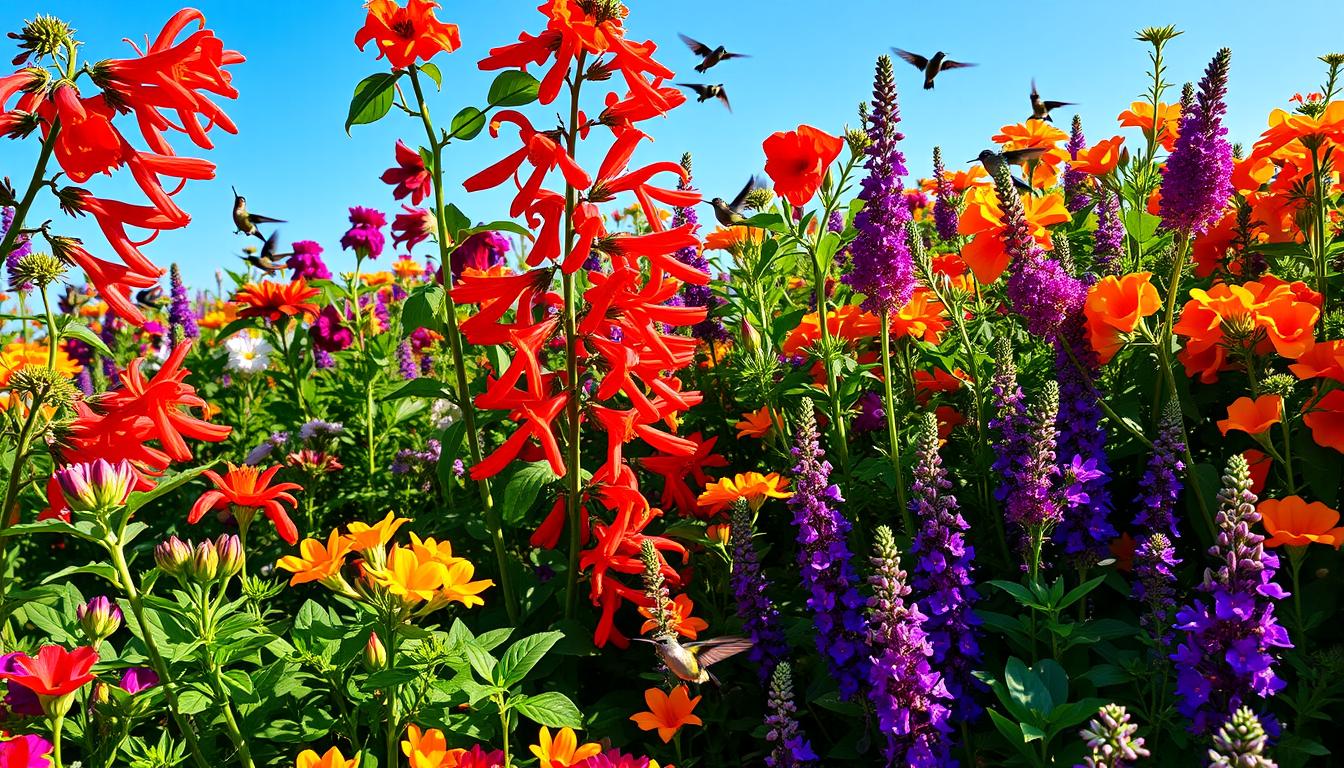Ready to make your backyard a hummingbird haven? I’m excited to guide you in creating a garden that hummingbirds will love. We’ll find the best plants and design a garden that attracts them.
We’ll explore colorful blooms and smart garden layouts. You’ll discover which plants hummingbirds prefer and how to arrange them. By the end, you’ll know how to make a hummingbird-friendly oasis in your backyard.
Get ready to turn your outdoor space into a lively spot for hummingbirds. Let’s start this exciting journey in hummingbird gardening together!
Why Attract Hummingbirds to Your Garden?
I love making my garden a haven for birds. Attracting hummingbirds is not just fun. It’s crucial for our local ecosystems. These tiny birds help keep our gardens healthy and full of life.
The Importance of Biodiversity
Hummingbirds boost biodiversity in our yards. They pollinate flowers as they eat, helping plants grow. This makes our gardens rich and varied.
Benefits to Your Garden Ecosystem
Hummingbirds do more than just look pretty. They eat small insects that harm plants. This means less need for harmful pesticides.
Their droppings also act as natural fertilizer, making your soil better. Creating a hummingbird haven makes your garden more enjoyable. It’s a joy to watch these colorful birds flit from flower to flower.
- Increased pollination of flowers
- Natural pest control
- Soil enrichment
- Enhanced garden beauty
By welcoming hummingbirds, you’re not just improving your garden. You’re helping the environment too. It’s a win-win for both you and nature!
Understanding Hummingbird Behavior
I’ve learned that knowing how hummingbirds act is key to attracting them. These tiny birds have unique habits that shape their visits to our gardens. Let’s explore their feeding patterns and migration habits to create the perfect hummingbird haven.
Feeding Patterns and Preferences
Hummingbirds are drawn to nectar-rich flowers. They feed up to 12 times per hour, so a steady supply of food is crucial. These birds prefer tubular blooms in bright colors, especially red. They’ll visit flowers throughout the day, with peak activity in early morning and late afternoon.
| Time of Day | Feeding Frequency | Preferred Flower Types |
|---|---|---|
| Early Morning | High | Trumpet-shaped, Red |
| Midday | Moderate | Various Colors, Tubular |
| Late Afternoon | High | Nectar-rich, Bright Colors |
Seasonal Migration Habits
Most hummingbirds in the U.S. migrate south for winter. They start their journey in late summer or early fall, returning in spring. During migration, they need high-energy food sources. Planting a variety of nectar-rich flowers that bloom at different times ensures a warm welcome for these tiny travelers.
I’ve found that understanding these patterns helps me plan my garden. By providing a mix of nectar-rich flowers that bloom throughout the seasons, I can attract hummingbirds from spring through fall. It’s amazing to watch these tiny birds flit from flower to flower, knowing I’ve created a perfect pit stop for their long journeys.
Best Plants for Attracting Hummingbirds
Creating a garden for hummingbirds is fun. It’s all about choosing the right plants. Let’s look at some flowering and native plants that hummingbirds love.
Flowering Plants to Consider
Hummingbirds are drawn to plants with tubular flowers in bright colors. Here are some great options:
- Trumpet Honeysuckle
- Cardinal Flower
- Fuchsia
- Columbine
- Penstemon
Native Plants That Thrive in Your Area
Native plants are perfect for hummingbirds. They fit your local climate and need less care. Here’s a table of native plants by region:
| Region | Native Plant | Bloom Time |
|---|---|---|
| Northeast | Coral Bells | Spring to Summer |
| Southeast | Trumpet Creeper | Summer to Fall |
| Midwest | Wild Bergamot | Summer |
| Southwest | Ocotillo | Spring |
| Northwest | Red-flowering Currant | Spring to Early Summer |
Plant a mix of flowering and native plants. This will make your garden a hummingbird paradise. Make sure to plant at different times to keep food available all season. With the right plants, your garden will buzz with life!
Annuals That Hummingbirds Love
I love attracting hummingbirds to my garden. Annuals are a great way to do it. They grow fast and add color quickly. Let’s look at two favorites that hummingbirds adore.
Salvia: A Vibrant Choice
Salvia is a top pick for hummingbird gardens. Its tubular flowers fit hummingbird beaks perfectly. Red varieties like ‘Hot Lips’ are especially appealing.
Salvia is easy to grow and blooms all summer. I plant it in sunny spots. I keep the soil moist but not too wet.
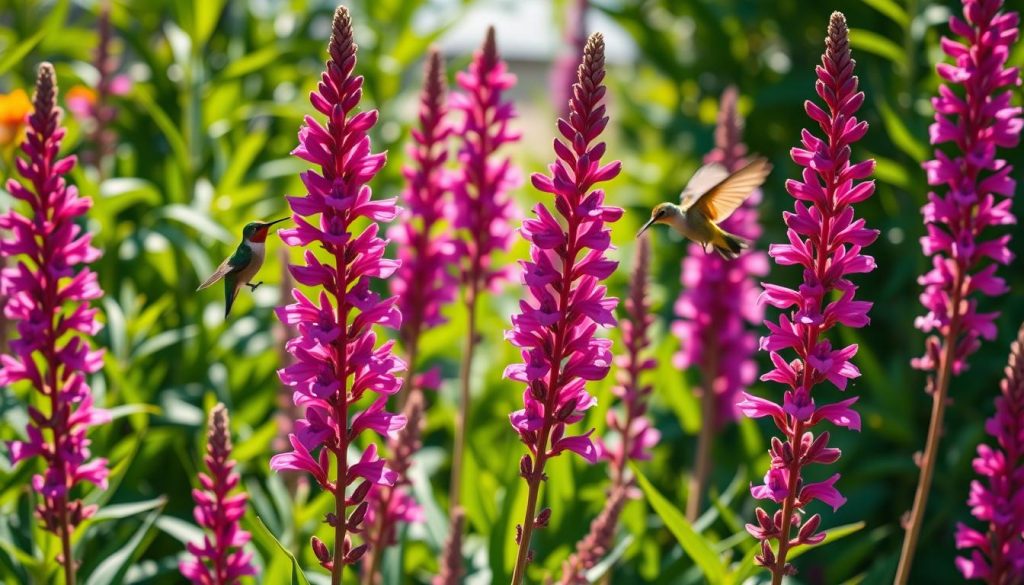
Zinnia: Easy to Grow and Colorful
Zinnias are another favorite for hummingbird gardens. They come in many colors and grow fast from seed. I sow zinnia seeds directly in the garden after the last frost.
These plants love full sun and well-drained soil. Their large, flat blooms are perfect for hummingbirds to rest and feed.
| Plant | Flower Color | Height | Bloom Time |
|---|---|---|---|
| Salvia | Red, Purple, Pink | 1-3 feet | Summer to Fall |
| Zinnia | Various | 6 inches – 4 feet | Summer to Frost |
Both salvia and zinnia have tubular flowers that hummingbirds love. Planting these annuals makes your garden vibrant and inviting. Remember to deadhead spent blooms to keep them flowering all season.
Perennials That Bring Hummingbirds
Perennials are a gardener’s dream for attracting hummingbirds year after year. These long-lasting plants offer a reliable food source for our tiny feathered friends. I’ve found two perennials that are particularly effective in drawing hummingbirds to my garden.
Bee Balm: A Fragrant Favorite
Bee Balm, with its vibrant red flowers for hummingbirds, is a showstopper in any garden. This native plant blooms from mid to late summer, providing a feast for hummingbirds. Its tubular flowers are perfectly shaped for their long beaks, making it a top choice for these tiny birds.
Trumpet Vine: A Bold Attraction
Trumpet Vine is another perennial that hummingbirds can’t resist. Its long, trumpet-shaped flowers come in shades of red and orange, colors that hummingbirds find irresistible. This vigorous climber can cover fences or trellises, creating a vertical garden that hummingbirds love to explore.
| Plant | Bloom Time | Color | Height | Sun Requirement |
|---|---|---|---|---|
| Bee Balm | Mid to Late Summer | Red, Pink, Purple | 2-4 feet | Full Sun to Partial Shade |
| Trumpet Vine | Summer to Fall | Red, Orange | 25-40 feet | Full Sun |
By incorporating these perennials into your garden, you’ll create a haven for hummingbirds. Remember to plant in clusters and provide a mix of heights to create an inviting landscape for these fascinating creatures.
How to Arrange Your Garden for Hummingbirds
Creating a garden for hummingbirds is more than just picking plants. The way you arrange your garden is key. I’ve discovered some tips to make your garden a hummingbird paradise.
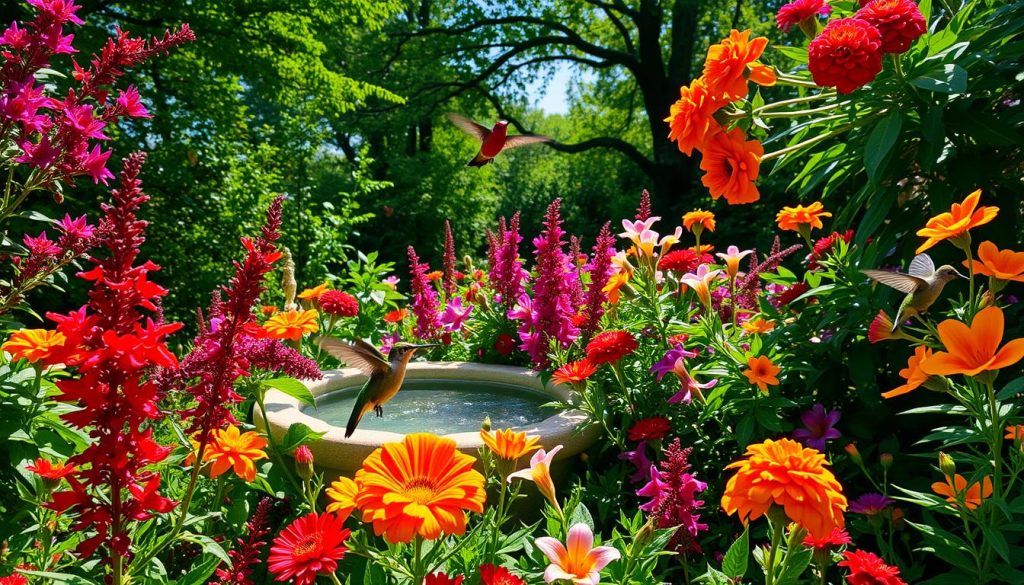
Planting in Clusters
Grouping plants together is a big help. It makes your garden more appealing to hummingbirds. They can easily find food in these clusters, saving energy.
Creating Vertical Layers with Height
Hummingbirds enjoy different heights for feeding. Start with low plants, then add medium ones, and end with tall ones. This not only looks good but also offers hummingbirds many places to eat and rest.
Remember, variety is important. Mix colors, shapes, and when plants bloom. This keeps hummingbirds coming back all season. With smart placement and diverse plants, your garden will be a hummingbird favorite!
Tips for Maintaining a Hummingbird-Friendly Garden
Creating a garden for hummingbirds is fun, but it needs care to thrive. I’ve found that regular upkeep is crucial. Here are some tips to keep your garden welcoming to hummingbirds.
Regular Watering and Fertilizing
Healthy plants draw in hummingbirds. I water my garden deeply once or twice a week, depending on the weather. I also fertilize with a balanced, organic mix every few weeks during the growing season. This keeps the flowers blooming, making my garden a hummingbird favorite.
Importance of Cleanliness in Plant Health
Clean plants are happy plants, and happy plants attract more hummingbirds! I remove dead flowers and leaves often. This keeps the garden looking good and prevents diseases. It also encourages more blooms, offering a steady nectar source for hummingbirds.
- Prune damaged or diseased parts promptly
- Clear fallen leaves to prevent mold growth
- Wash leaves gently to remove dust and pests
By following these simple tips, your garden will stay healthy and lively all season. A well-kept garden is a hummingbird magnet!
Attracting Hummingbirds with Container Gardens
Container gardens are a great way to draw hummingbirds, even with little space. Mixing colorful plants with feeders makes a perfect spot for these birds.
Ideal Container Plants
Choose plants with tubular flowers that hummingbirds adore. Some top picks are:
- Fuchsia
- Lantana
- Salvia
- Petunia
- Calibrachoa
These plants offer nectar and brighten up your area. Mix them for a lively and diverse look.
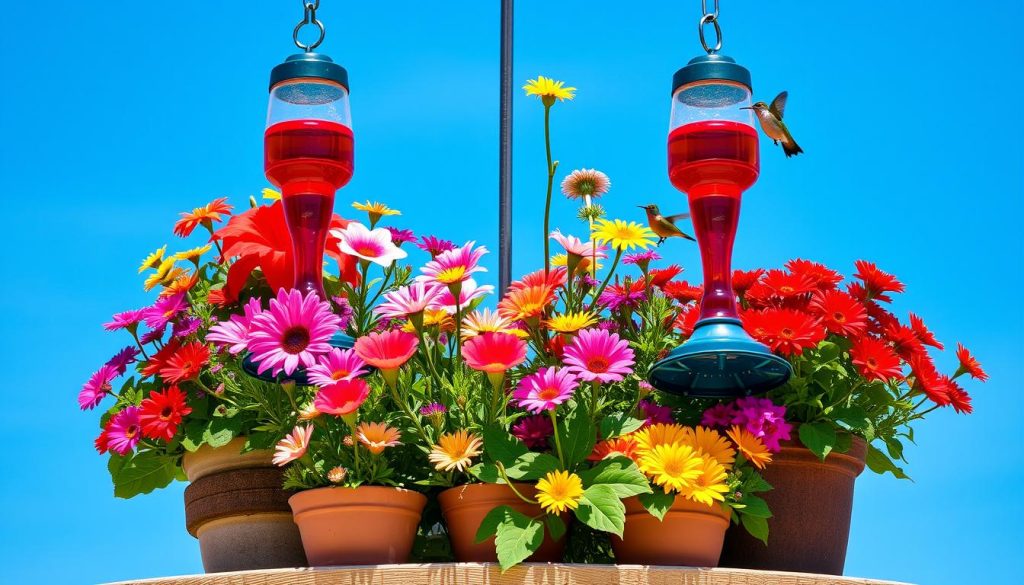
Placement Tips for Best Results
Where you place your garden matters a lot. Here’s how to do it right:
- Put containers by windows for easy watching
- Group them to make a “feeding station”
- Hang feeders close to your plants
- Make sure plants get some sun to full sun
By mixing plants with feeders, you’ll make a spot hummingbirds love. Keep feeders clean and filled to keep them coming.
| Container Plant | Flower Color | Sun Requirement | Blooming Season |
|---|---|---|---|
| Fuchsia | Pink, Purple, Red | Partial Shade | Spring to Fall |
| Lantana | Multi-colored | Full Sun | Summer to Fall |
| Salvia | Red, Purple, Blue | Full Sun | Summer |
| Petunia | Various | Full Sun | Spring to Fall |
| Calibrachoa | Various | Full Sun | Spring to Fall |
Incorporating Water Features to Attract Hummingbirds
Water features are key to a hummingbird garden. These birds need more than just nectar. Let’s look at how to add refreshing elements for a hummingbird haven.
Birdbaths: Essential for Hydration
Birdbaths are a must for hummingbird gardens. Choose shallow baths with gentle slopes for easy access. Place them near flowers where hummingbirds feed. Clean the bath daily to stop algae and mosquito growth.
Misting Stations: A Refreshing Spot
Misting stations are a unique addition. Hummingbirds love flying through fine water sprays. Set one up near flowers or in a shaded area. It’ll create a cool spot that hummingbirds can’t resist.
| Water Feature | Benefits | Maintenance |
|---|---|---|
| Birdbath | Hydration, bathing | Daily cleaning, refilling |
| Misting Station | Cooling, feather care | Weekly nozzle check, water source monitoring |
Adding these water features makes your garden diverse and inviting. Remember, keep your water sources clean and running. This ensures hummingbirds return every day.
Observing Hummingbirds in Your Garden
Creating hummingbird havens is just the start of a thrilling adventure. Once these tiny wonders visit your garden, you’ll want to watch them closely. I’ve found that observing hummingbirds is both rewarding and educational.
Best Times for Birdwatching
Hummingbirds are most active in the early morning and late afternoon. I often see them buzzing around my garden just after sunrise and before sunset. These times give you the best chance to see them feed, perch, and even perform aerial displays.
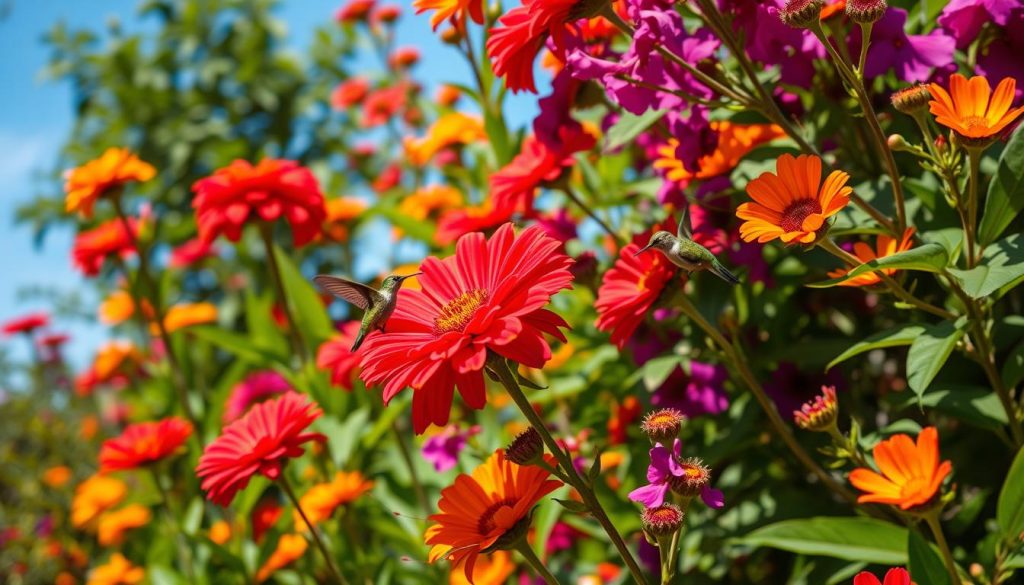
Keeping a Journal of Your Observations
I’ve started a journal to track my hummingbird visitors. It’s a great way to learn about their behaviors and preferences. In my journal, I note:
- Dates of first and last sightings each season
- Types of hummingbirds seen
- Favorite flowers they visit
- Unique behaviors observed
This information helps me improve my garden for these delightful creatures. By tracking their preferences, I can plant more of their favorite flowers. It’s amazing how much you can learn by simply watching and recording your observations!
Seasonal Changes: Keeping Your Garden Attractive Year-Round
I love making a garden that attracts hummingbirds all year. It’s a fun challenge that keeps them coming back. Let’s see how to keep your garden lively for hummingbirds through the seasons.
Fall and Winter Plant Options
When summer ends, we need plants that attract hummingbirds in the cold. Late-blooming perennials like pineapple sage and Mexican bush sage work well. They offer nectar when other plants stop blooming.
In winter, evergreen shrubs like winter-flowering mahonia are key. Its yellow flowers brighten up winter and feed hummingbirds.
Maintaining a Continuous Bloom Cycle
To keep hummingbirds visiting all year, I plan for a garden that blooms continuously. I choose plants that bloom at different times. Here’s a simple plan I follow:
| Season | Plants | Bloom Time |
|---|---|---|
| Spring | Columbine, Bleeding Heart | March – May |
| Summer | Bee Balm, Cardinal Flower | June – August |
| Fall | Pineapple Sage, Fuchsia | September – November |
| Winter | Mahonia, Winter Jasmine | December – February |
By using this plan, my garden always has something for hummingbirds. Consistency is the secret to keeping them coming back all year.
Creating a Hummingbird Sanctuary
Let’s work together to make a hummingbird paradise. By following my tips, you’ll create a spot hummingbirds will adore. Think like a hummingbird to give them everything they need.
Reducing Pesticide Use
One key step is to use fewer pesticides. These can harm hummingbirds and kill their food. I choose natural ways to keep pests away, like planting together or picking bugs by hand. This keeps my garden safe for hummingbirds and other animals.
Providing Shelter and Nesting Areas
Hummingbirds need more than food – they need places to rest and raise their young. I add dense shrubs and small trees for shelter. Some might even nest there. Offering food and shelter helps these birds stay longer.
Creating a hummingbird sanctuary is a journey. It takes time and effort, but seeing these tiny wonders in your garden is rewarding. With patience and the right approach, you’ll soon have a hummingbird haven right outside your window.

